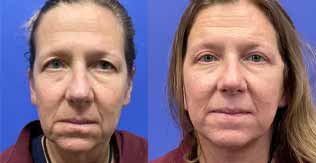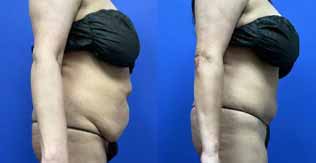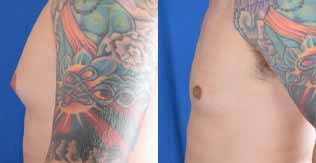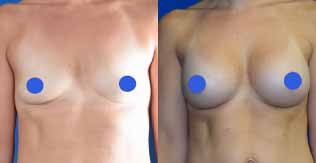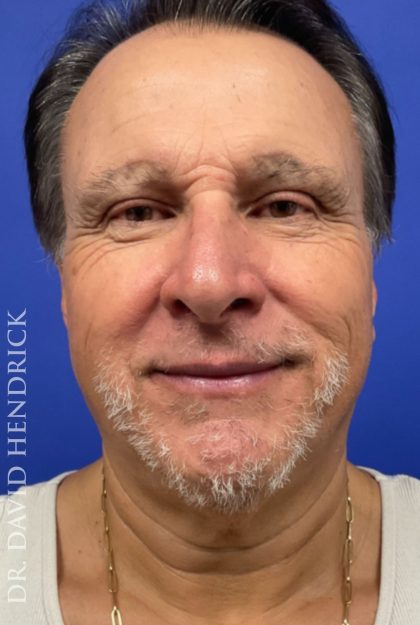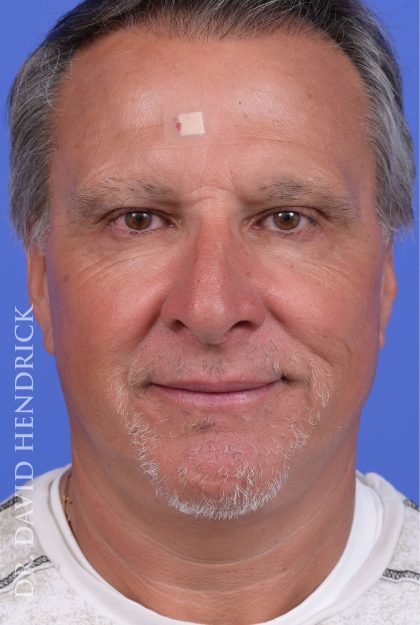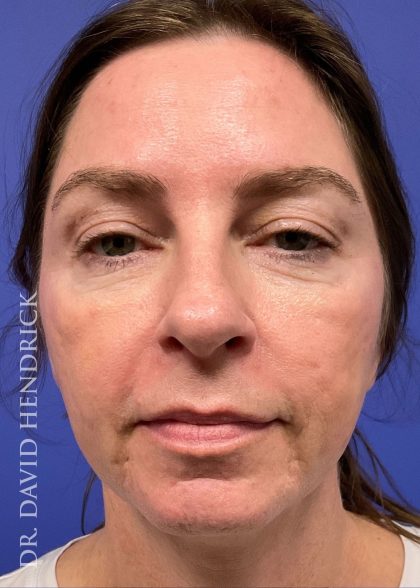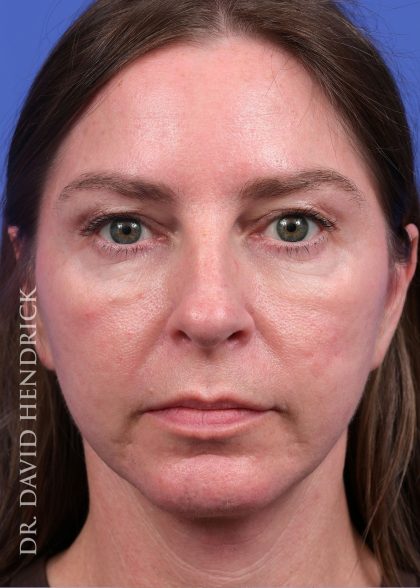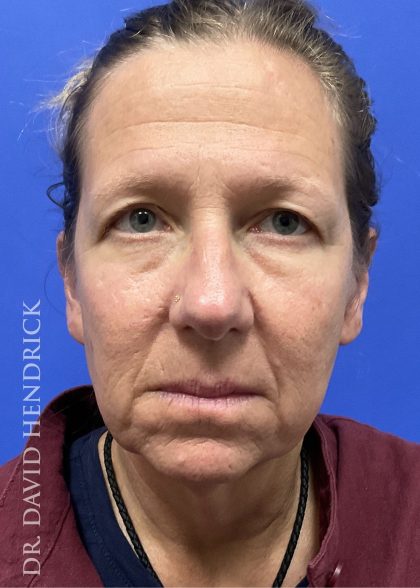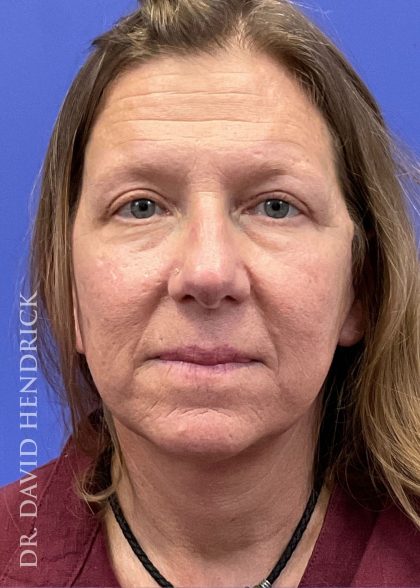Facelift
Offered at our convenient location in Denver
The rhytidectomy, or facelift, is the single most comprehensive facial rejuvenation surgery available. It lifts and tightens sagging skin in the face, restoring a more youthful appearance, and enabling patients to feel confident. Facial aging affects different people in different ways but wrinkles, lines, and sagging will eventually show on any face with time.
There are less involved ways to fight signs of aging in the face, such as the use of injectables and skin treatments. But these are only semi-permanent measures that require a patient to return to the doctor’s office for regular maintenance. With a facelift, results are permanent. Many years of accumulated signs of aging can be addressed in one surgery, ensuring you benefit from the results for many years.
Triple board-certified Dr. David A. Hendrick performs facelifts to refine and beautify his patients’ complexions at Millard Plastic Surgery Services, Denver. To book a personal consultation to discuss facial rejuvenation, call our Englewood office at (303) 792-5665 or fill out a simple inquiry form to book your first appointment.
Contents
Before and After Photos
The Facelift
Over 125,000 facelifts are performed in the United States each year. (1) The main objective of the facelift is to rejuvenate the face by repositioning underlying tissues and removing excess skin on either side of the face so the remaining skin can be lifted, tightened, and secured.
A patient may seek a facelift to address a wide variety of aesthetic complaints. One of the most common complaints is worsening skin sagging (ptosis), others may complain about deeper lines and wrinkles. Whatever the issue, the processes that cause visible signs of aging don’t happen overnight, but rather happen steadily over time.
Common Signs of Facial Aging
- Sagging Skin
- Crepey Skin
- Nasolabial Folds
- Prominent Jowls
- Poorly Defined Jawline
- Poorly Defined Chin
- Facial Hollowing
- Neck Bands (Platysmal Banding)
There is no “standard” process for facial aging. Time and gravity affect each of us differently, depending on our genes, our health, our environment, and our skin maintenance. Skin care products for the aging face have come a long way. And in our later years, we adapt our skin care routine to account for the changes that occur. But even the most nourishing, nutrient-rich moisturizers have little long-term impact on the most prominent wrinkles and lines, and virtually no impact on sagging. These problems can only be addressed permanently through facelift surgery.
What Happens to Skin as We Get Older?
Molecules in the skin change over time. A framework outside of the skin cells, the extracellular matrix (ECM), is the key scaffold of our skin. It contains essential collagen and elastin, which keep tissues supple, strong, and in good overall condition.
These molecules are amino acids, long protein chains that form a large portion of the ECM. They play the following roles.
- Contribute to skin resilience
- Maintain skin hydration
- Reduce signs of aging
- Contribute to overall skin health
The body produces less collagen and elastin the older we get. And, because of their strength, these molecules have a slow turnover rate. Unfortunately, this means they are susceptible to age-related chemical and biological changes in the body. (2) This translates into a decline in condition, and the worsening of rhytides and sagging.
Benefits of a Facelift at Millard Plastic Surgery Center
During a facelift procedure, Dr. Hendrick lifts and tightens skin by making incisions along the edge of the face around the ears and along the hairline. The surgery has numerous benefits, which include the following.
- Lifts and smooths sagging areas of the face.
- Smooths away deeper wrinkles and lines.
- Achieves significant rejuvenation in multiple areas.
- Customizable treatment plans for the face and neck
- Softens facial contours for a youthful appearance
- Provides permanent solutions to facial aging
- Easily combined with other anti-aging measures
There is more than one type of facelift procedure to opt for, depending on a patient’s individual concerns.
Types of Facelift
The facelift is one of the most sought-after plastic surgeries in the world. It’s also one of the most customizable. In addition to other benefits, your surgeon can tailor your procedure to meet specific aesthetic goals.
- Traditional Facelift: The standard facelift procedure that improves the overall appearance of the face and upper neck region.
- Deep Plane/SMAS Facelift: A more complex surgery that repositions underlying facial musculature.
- Midface Lift: Focuses on definition in the cheeks, with shorter incisions at the ears.
- Mini Facelift: Addresses mild-to-moderate sagging, suitable for younger patients with signs of aging.
- Extended Facelift: Tightens skin in the midface, lower face, and the neck, with a longer incision that covers more of the neck than a traditional facelift.
Book a consultation at Millard Plastic Surgery Center and discover the benefits of a facelift!
Candidates
The ideal facelift candidate has significant skin sagging in one or multiple areas of the face that can be addressed successfully with this surgery. Usually, patients are between 40-60 years of age. Deeper wrinkles and lines in the face and neck areas, such as pronounced nasolabial folds and jowling may benefit particularly from the procedure.
Although there are no conditions that completely rule out a facelift, there are some things that could mean it is not a good fit. These include the following.
- Serious health conditions such as diabetes, obesity, heart disease, and high blood pressure
- Medical conditions that affect blood coagulation (clotting)
- Heavy smokers and/or drinkers
- Unrealistic/distorted expectations of what a facelift procedure can achieve
- Unable to follow post-surgery aftercare instructions
Personal Consultation
Your personal consultation at our Englewood office is an opportunity for you to meet with Dr. Hendrick and ask questions about the procedure. We will ask you to fill out some forms detailing your medical history and your current health. We will also ask you to tell us if you have undergone any prior facial surgeries.
During your visit, Dr. Hendrick will examine your skin’s quality, including its elasticity, and note the severity of your wrinkles and lines, and the extent of facial skin sagging. Please use this opportunity to show him the areas you are most concerned about! Once we have all the relevant information, and he has performed a physical examination of your face, he will determine if a facelift is the best procedure for you. After this, we will start the planning process for your treatment and arrange your surgery date.
Preparation
There are some instructions you will need to follow to prepare for your surgery, which we will provide in written format before your surgery date. These include the following.
- Stop taking medications that thin the blood (e.g. aspirin, Motrin, NSAIDs).
- Stop taking dietary supplements with blood-thinning properties (e.g. vitamin E, omega-3, ginseng).
- Quit smoking completely (the chemicals in cigarettes may affect the healing process).
- Arrange transportation to and from our surgery center with a friend or family member.
- Arrange for someone to stay with you and help you with daily tasks for the first 24 hours at home after your procedure.
- Fill all prescriptions you will need during recovery in the days before your surgery.
Facelift Procedure
Each facelift procedure is mapped out in detail in a patient’s treatment plan before it takes place. When you arrive, we will give you a brief overview of what will happen, before preparing you for your procedure. Dr. Hendrick will begin by demarcating the incision points on the sides of your face with a marker.
After anesthesia is administered, the first stage of a traditional facelift involves making a long incision. In a traditional facelift procedure, the surgeon places the incision in the hairline from the lower temple, following the crease between the face and front of the ear, then curving back behind the ear and back into the hairline.
Once the initial incisions are made, Dr. Hendrick will lift the skin away to reveal the underlying tissues. The required amount of excess skin is then removed from the area. After this, he will re-drape and carefully align the remaining skin along the incision, ensuring a tighter facial contour and a smoothing of targeted wrinkles. Once the necessary adjustments to the area have been made, the incision is sutured, leaving a discreet scar once healing is complete.
Recovery & Results
You will be required to wear a compression garment to aid the healing process. In the initial weeks of your recovery, you can expect swelling, bruising, and some discomfort in the face. This can be relieved with medication prescribed by Dr. Hendrick. You may notice some asymmetry in your face, but this will resolve once the swelling goes down. It is very important you continue to refrain from smoking for the duration of your recovery, as the chemicals in cigarettes constrict blood supply and hinder the healing process.
You should arrange time off work at home for at least one to two weeks. It is very important you rest well at home, with no exercise or activities that will put strain on your sutures. Avoid leaning forward, and do not lift any heavy items for at least one week. You will also need to sleep in a slightly raised position for 2-3 weeks. Recovery time for a facelift is 3-6 weeks, though every patient’s healing process is unique to them.
Once your initial healing is complete, it may take a little time for your results to settle. But once they do, you will see a marked difference in your facial appearance! You can expect to see your final, rejuvenating results in around 6 months.
Cost of a Facelift in Denver, CO
Every facelift treatment plan is different. Therefore, costs will vary from patient to patient. For financing information, please see our website. Book your consultation to discuss facelift surgery at Millard Plastic Surgery Center by calling (303) 792-5665 or by filling out our simple online contact form.
See Millard Plastic Surgery Center showcased in multiple local and national publications on our media page. You can also read more about the services we offer by reading our blog.
References
- Rohrich, R. J., Sinno, S., & Vaca, E. E. (2019). Getting Better Results in Facelifting. Plastic and Reconstructive Surgery – Global Open, 7(6), e2270. https://doi.org/10.1097/gox.0000000000002270
- Birch, H. L. (2018). Extracellular Matrix and Ageing. Sub-Cellular Biochemistry, 90, 169–190. https://doi.org/10.1007/978-981-13-2835-0_7
